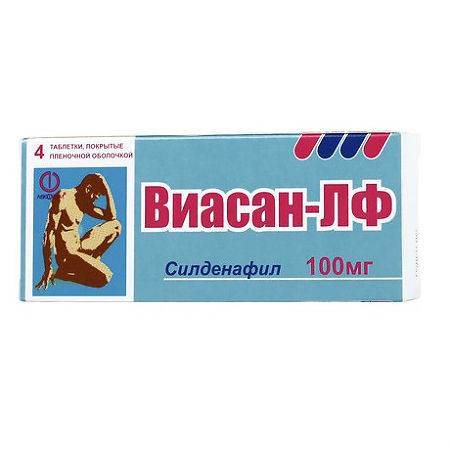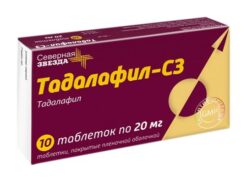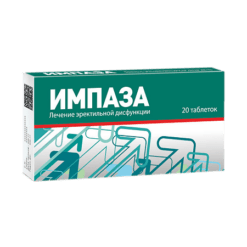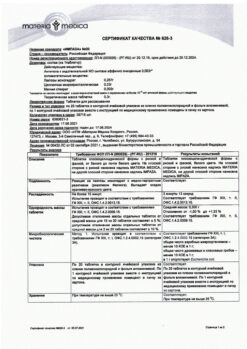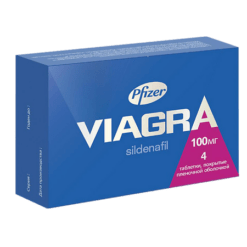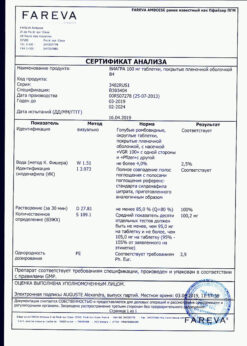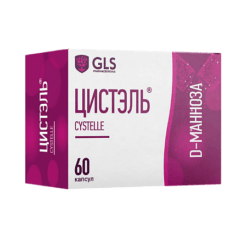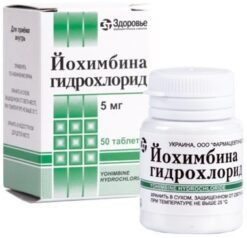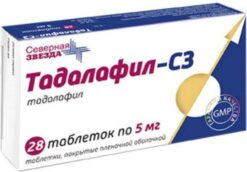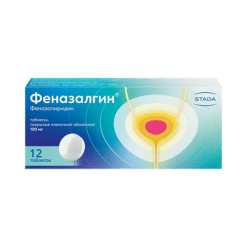No products in the cart.
Viasan-LF, 100 mg 4 pcs
€1.00
Out of stock
(E-mail when Stock is available)
Description
A product for the treatment of erectile dysfunction. It restores impaired erectile function and provides a natural response to sexual arousal.
Sildenafil is a potent and selective inhibitor of cGMP-specific phosphodiesterase type 5 (PDE5), which is responsible for breakdown of cGMP in the cavernous body.
Sildenafil does not have a direct relaxing effect on the cavernous body, but actively enhances the relaxing effect of nitric oxide on this tissue. During sexual arousal local release of NO under the influence of sildenafil leads to inhibition of FDE5 and increase of cGMP level in the cavernous body, as a result of this there is relaxation of smooth muscles and increase of blood flow in the cavernous body.
Sildenafil can cause mild and transient color (blue/green) impairment. The inhibition of FDE6, which is involved in the transmission of light in the retina, is thought to be the presumed mechanism of color vision impairment. In vitro studies have shown that the effect of sildenafil on FDE6 is 10 times inferior to its activity against FDE5.
In vitro studies show that sildenafil’s activity against FDEP5 is 10-10000 times greater than its activity against other phosphodiesterase isoforms (FDEP 1, 2, 3, 4 and 6). In particular, sildenafil activity against FDE5 is 4,000 times greater than its activity against FDE3 – cAMP-specific phosphodiesterase involved in heart contraction.
Pharmacokinetics
After oral administration sildenafil is rapidly absorbed. Absolute bioavailability is on average 40% (25-63%). After a single oral dose of 100 mg, Cmax is 18 ng/mL and is reached when taken on an empty stomach within 30-120 minutes.
If sildenafil is taken in combination with fatty foods, the absorption rate is reduced; Tmax is increased by 60 min and Cmax is reduced by an average of 29%. The Vd of sildenafil in equilibrium is on average 105 L. Sildenafil and its main circulating N-desmethyl metabolite are approximately 96% bound to plasma proteins.
Protein binding is independent of the total concentration of sildenafil. Less than 0.0002% of the dose (188 ng on average) was detected in semen 90 min after sildenafil administration.
Sildenafil is metabolized primarily by the microsomal liver isoenzymes CYP3A4 (main pathway) and CYP2C9.
The main circulating metabolite, which is formed by N-desmethylation of sildenafil, undergoes further metabolism. In terms of selectivity of action on FDE, the metabolite is comparable with sildenafil, and its activity against FDE5 in vitro is approximately 50% of the activity of sildenafil itself. Plasma concentration of the metabolite is about 40% of that of sildenafil. N-desmethylmetabolite undergoes further metabolism; its terminal T1/2 is about 4 hours.
The total clearance of sildenafil from the body is 41 l/h, and the T1/2 during the terminal phase is 3-5 hours. After oral administration sildenafil is excreted as metabolites mainly in the feces (about 80% of the dose) and, to a lesser extent, in the urine (about 13% of the dose).
In elderly patients (65 years and older) sildenafil clearance is decreased, and plasma concentrations of free active substance are about 40% higher than its concentration in young (18-45 years) patients.
In mild (KC 50-80 ml/min) and moderate (KC 30-49 ml/min) renal impairment, the pharmacokinetic parameters of sildenafil are unchanged after oral administration once (50 mg). In severe renal failure (CK≤30 ml/min), sildenafil clearance is decreased, resulting in approximately two-fold increase of AUC (100%) and Cmax(88%) compared to these parameters in normal renal function in patients of the same age group.
In patients with cirrhosis (Child-Pugh class A and B), sildenafil clearance is decreased, resulting in increased AUC (84%) and Cmax (47%) compared to those in normal liver function in patients in the same age group.
Indications
Indications
The treatment of erectile dysfunction characterized by the inability to achieve or maintain an erection of the penis sufficient for satisfactory intercourse.
Active ingredient
Active ingredient
Composition
Composition
One tablet contains:
The active ingredient:
sildenafil (in the form of citrate) – 100 mg;
excipients:
microcrystalline cellulose, potato starch, magnesium stearate, milk sugar (lactose), opadray II (talc (14.8%), macrogol (20.2%), titanium dioxide (23.85%), polyvinyl alcohol (40.0%), sunset yellow aluminum varnish (E110) (0.02%), indigo carmine aluminum varnish (E132) (0.75%), brilliant blue aluminum varnish (E133) (0.38%).
How to take, the dosage
How to take, the dosage
It is taken orally about 1 hour before planned sexual activity.
The single dose is 50 mg. Depending on efficacy and tolerability, the dose may be increased to 100 mg or decreased to 25 mg. The maximum single dose is 100 mg.
The maximum frequency of use is once daily.
In elderly patients over 65 years of age and with concomitant renal or hepatic impairment, the dose is 25 mg.
Interaction
Interaction
Concomitant use of CYP3A4 inhibitors (erythromycin, cimetidine) decreases sildenafil clearance and increases sildenafil plasma concentration.
Concomitant use of indinavir, saquinavir, ritonavir increases plasma Cmax and AUC of sildenafil due to inhibition of CYP3A4 isoenzyme by indinavir, saquinavir, ritonavir.
The stronger CYP3A4 isoenzyme inhibitors, such as ketoconazole or itraconazole, can be expected to increase plasma concentrations of sildenafil
Simultaneous use with nitrates increases the hypotensive effect of nitrates.
A case of development of rhabdomyolysis symptoms after a single dose of sildenafil in a patient receiving simvastatin has been described.
Special Instructions
Special Instructions
An examination of the cardiovascular system should be performed before starting sildenafil.
With caution, use in patients with anatomical deformities of the penis (e.g., angulation, cavernous fibrosis, or Peyronie’s disease) and people with diseases that predispose to the development of priapism (such as sickle cell anemia, multiple myeloma, or leukemia).
Do not use in patients for whom sexual activity is undesirable.
With caution, use in patients with a tendency to bleeding, in the acute phase of gastric and duodenal ulcer, in hereditary retinitis pigmentosa.
There is no evidence of carcinogenicity of sildenafil in experimental studies. Bacterial and in vivo mutagenicity tests were negative.
Impact on driving and operating ability
Sildenafil has no effect on driving and operating ability.
In impaired renal function
In impaired renal function, the dose is 25 mg.
In impaired liver function
In impaired liver function, the dose is 25 mg.
Use in the elderly
For elderly patients over the age of 65, the dose is 25 mg.
Per pediatric use.
Sildenafil is not used in patients under the age of 18 years.
Contraindications
Contraindications
Simultaneous use of nitric oxide donors or nitrates in any form, hypersensitivity to sildenafil.
Side effects
Side effects
CNS disorders: headache, hot flashes, dizziness, insomnia are possible.
Digestive system disorders: dyspepsia, asthenia, diarrhea, abdominal pain, nausea are possible.
Muscular system disorders: arthralgia, myalgia, increased muscle tone.
Respiratory system disorders: nasal congestion, pharyngitis, rhinitis, sinusitis, respiratory tract infections, respiratory disorders.
A visual organ: changes in vision (mild and transient; mainly changes in the color of objects, as well as increased perception of light and impaired visual clarity), conjunctivitis.
Others: flu-like syndrome, development of infectious diseases, symptoms of vasodilation, back pain, rash, urinary tract infections, prostate disorders; in single cases, priapism.
Overdose
Overdose
Symptoms: fever, dizziness, facial flushing, headache, blurred vision, dyspeptic phenomena, decreased blood pressure.
Treatment: symptomatic therapy; dialysis is ineffective.
Similarities
Similarities
Additional information
| Manufacturer | Lekpharm, Belarus |
|---|---|
| Medication form | pills |
| Brand | Lekpharm |
Related products
Buy Viasan-LF, 100 mg 4 pcs with delivery to USA, UK, Europe and over 120 other countries.

